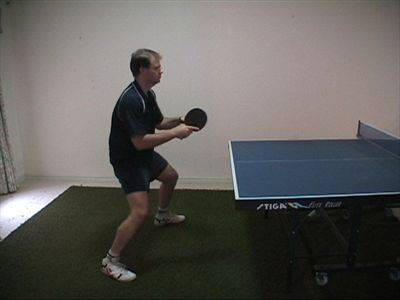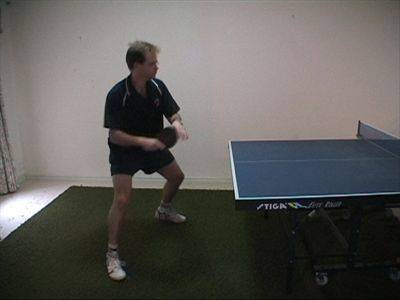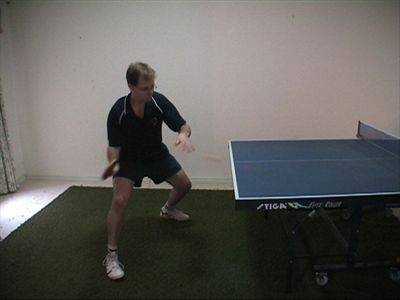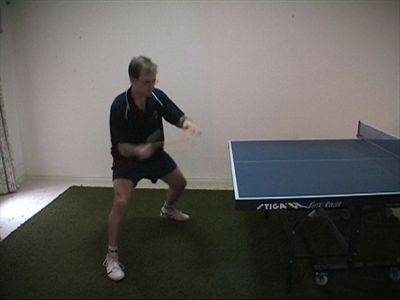In this tutorial, we will be looking at what should probably be the very first table tennis stroke that you learn – the forehand counterhit. This stroke is the foundation of all forehand topspin strokes, so by learning how to hit it correctly, you will find it easier to learn the more advanced strokes such as the forehand drive and loop, which are essential for high level play.
In the forehand counterhit against light to medium topspin, the idea is to hit the ball over the net with medium speed and a little topspin to help bring the ball down on the other side of the table.
Ready Position

Points to look for:
- The feet are placed with the right foot slightly further back than the left foot, to make it easier to put weight on the right leg during the stroke.
- Most of the weight is on the balls of the feet to allow quicker movement. Too much weight on the heels will slow down movement, and too much weight on the toes will affect balance.
- The weight is evenly distributed between the left and right legs.
- The knees are bent and the feet are around one and a half times shoulder width apart. The torso is also leaning slightly forward. This gives a lower center of gravity for better balance, and allows for easy movement in all directions.
- Shoulders are in line with the legs, with the right shoulder slightly behind the left.
- The arms are held roughly shoulder width apart, with around a 90 degree angle at the elbow. The bat should be above the table to allow easy stroking of short balls.
Beginning of Backswing

The ball is coming to the forehand side and the decision has been made to play a forehand counterhit. The backswing begins the stroke.
Points to look for:
- The right foot and leg have turned to the right, in preparation for having more bodyweight placed upon them.
- The hips, waist and shoulders have also turned to the right, although the head is still facing forward watching the ball.
- The bat has only moved slightly backwards at this point. The amount that the bat moves backwards will vary from player to player, and will also be affected by the amount of power the stroke is hit with.
End of Backswing

The ball is about to bounce on the table, and the backswing has finished.
Points to look for:
- Some of the bodyweight has been transferred onto the right leg. This will allow the player to turn his hips, waist and shoulders to the right and then back to the left without losing balance.
- The left and right arms are around shoulder width apart, but they are now pointing in parallel to the end of the table. Notice that the shoulders have turned more than the hips and waist.
- The right shoulder has dipped slightly, so that the left hand is slightly higher than the right hand. The right hand is at a height that is a little lower than the expected maximum height of the bounce of the ball.
- The head has turned to allow the player to keep watching the ball comfortably and closely.
Beginning of Forward Swing

The ball has now bounced, and the player is beginning to swing forward at the ball.
Points to look for:
- The head has continued to turn to watch the ball closely.
- The angle of the bat is at a roughly 45 degree angle, with the top edge of the bat pointing towards the camera.
- The hips, waist and shoulders have just begun to turn forwards again.
Contact with the Ball

Contact has been made with the ball.
Points to look for:
- The player has watched the bat contact the ball.
- The hips, waist and shoulders have continued to turn back towards the left, helping provide extra power when hitting the ball.
- The forearm and bat are moving faster than the shoulders, as shown by the slight blurring in the photograph.
- If the ball was compared to a clockface, the bat has made contact at a point roughly around the number 10, while the bat was moving mainly forwards and slightly up. Note that the angle of the bat remains at around 45 degrees. This movement makes the ball go mainly forward and a little upwards, with a light amount of topspin generated by the small brush of the ball.
End of Forward Swing

The forward swing has come to an end, and the ball is on its way.
Points to look for:
- The player is now watching his opponent at the other end of the court, rather than the flight of the ball.
- The hips, waist and shoulders have almost completed turning back to the left.
- The hips, waist and shoulders are a little higher than the original ready position.
- The racket has moved a little more forward and further upwards. The tip of the racket is now pointing upwards, in what is called ‘the salute’.
Return to Ready Position

The player begins to return to his ready position before the next stroke.
Points to look for:
- The right foot and leg have turned to the left to get back into a neutral position.
- The player simply has to let his arms drop a little to have his bat back into the ready position. The shoulders will also turn a little back to the right to resume their normal position.
- His knees have bent as he returns to his basic crouch position.
- His bodyweight is again evenly distributed between his left and right legs, and on the balls of his feet.

